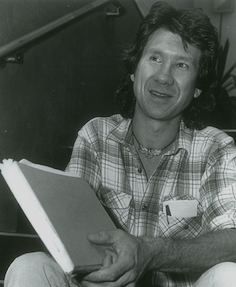
Lisp machines are general-purpose computers designed to efficiently run Lisp as their main software and programming language, usually via hardware support. They are an example of a high-level language computer architecture. In a sense, they were the first commercial single-user workstations. Despite being modest in number Lisp machines commercially pioneered many now-commonplace technologies, including effective garbage collection, laser printing, windowing systems, computer mice, high-resolution bit-mapped raster graphics, computer graphic rendering, and networking innovations such as Chaosnet. Several firms built and sold Lisp machines in the 1980s: Symbolics, Lisp Machines Incorporated, Texas Instruments, and Xerox. The operating systems were written in Lisp Machine Lisp, Interlisp (Xerox), and later partly in Common Lisp.

Marvin Lee Minsky was an American cognitive and computer scientist concerned largely with research of artificial intelligence (AI). He co-founded the Massachusetts Institute of Technology's AI laboratory and wrote several texts concerning AI and philosophy.
Maclisp is a programming language, a dialect of the language Lisp. It originated at the Massachusetts Institute of Technology's (MIT) Project MAC in the late 1960s and was based on Lisp 1.5. Richard Greenblatt was the main developer of the original codebase for the PDP-6; Jon L. White was responsible for its later maintenance and development. The name Maclisp began being used in the early 1970s to distinguish it from other forks of PDP-6 Lisp, notably BBN Lisp.
Kent M. Pitman (KMP) is a programmer who has been involved for many years in the design, implementation, and use of systems based on the programming languages Lisp and Scheme. Since 2010, he has been President of HyperMeta, Inc.

Gerald Jay Sussman is the Panasonic Professor of Electrical Engineering at the Massachusetts Institute of Technology (MIT). He has been involved in artificial intelligence (AI) research at MIT since 1964. His research has centered on understanding the problem-solving strategies used by scientists and engineers, with the goals of automating parts of the process and formalizing it to provide more effective methods of science and engineering education. Sussman has also worked in computer languages, in computer architecture, and in Very Large Scale Integration (VLSI) design.

John McCarthy was an American computer scientist and cognitive scientist. He was one of the founders of the discipline of artificial intelligence. He co-authored the document that coined the term "artificial intelligence" (AI), developed the programming language family Lisp, significantly influenced the design of the language ALGOL, popularized time-sharing, and invented garbage collection.

Computer Science and Artificial Intelligence Laboratory (CSAIL) is a research institute at the Massachusetts Institute of Technology (MIT) formed by the 2003 merger of the Laboratory for Computer Science (LCS) and the Artificial Intelligence Laboratory. Housed within the Ray and Maria Stata Center, CSAIL is the largest on-campus laboratory as measured by research scope and membership. It is part of the Schwarzman College of Computing but is also overseen by the MIT Vice President of Research.
HAKMEM, alternatively known as AI Memo 239, is a February 1972 "memo" of the MIT AI Lab containing a wide variety of hacks, including useful and clever algorithms for mathematical computation, some number theory and schematic diagrams for hardware – in Guy L. Steele's words, "a bizarre and eclectic potpourri of technical trivia". Contributors included about two dozen members and associates of the AI Lab. The title of the report is short for "hacks memo", abbreviated to six upper case characters that would fit in a single PDP-10 machine word.
POP-11 is a reflective, incrementally compiled programming language with many of the features of an interpreted language. It is the core language of the Poplog programming environment developed originally by the University of Sussex, and recently in the School of Computer Science at the University of Birmingham, which hosts the main Poplog website.

Christopher Gale Langton is an American computer scientist and one of the founders of the field of artificial life. He coined the term in the late 1980s when he organized the first "Workshop on the Synthesis and Simulation of Living Systems" at the Los Alamos National Laboratory in 1987. Following his time at Los Alamos, Langton joined the Santa Fe Institute (SFI), to continue his research on artificial life. He left SFI in the late 1990s, and abandoned his work on artificial life, publishing no research since that time.
Richard P. Gabriel is an American computer scientist known for his work in computing related to the programming language Lisp, and especially Common Lisp. His best known work was a 1990 essay "Lisp: Good News, Bad News, How to Win Big", which introduced the phrase Worse is Better, and his set of benchmarks for Lisp, termed Gabriel Benchmarks, published in 1985 as Performance and evaluation of Lisp systems. These became a standard way to benchmark Lisp implementations.
In the history of artificial intelligence, an AI winter is a period of reduced funding and interest in artificial intelligence research. The field has experienced several hype cycles, followed by disappointment and criticism, followed by funding cuts, followed by renewed interest years or even decades later.
Mac Hack is a computer chess program written by Richard D. Greenblatt. Also known as Mac Hac and The Greenblatt Chess Program, it was developed at the Massachusetts Institute of Technology. Mac Hack VI was the first chess program to play in human tournament conditions, the first to be granted a chess rating, and the first to win against a person in tournament play. A pseudocode for the program is given in Figure 11.16 of.

John Vogel Guttag is an American computer scientist, professor, and former head of the department of electrical engineering and computer science at MIT. He conducts research on computer networks and medical applications of AI as co-lead of the MIT Computer Science and Artificial Intelligence Laboratory's Networks and Mobile Systems Group.

Patrick Henry Winston was an American computer scientist and professor at the Massachusetts Institute of Technology. Winston was director of the MIT Artificial Intelligence Laboratory from 1972 to 1997, succeeding Marvin Minsky, who left to help found the MIT Media Lab. Winston was succeeded as director by Rodney Brooks.
The AI Memos are a series of influential memorandums and technical reports published by the MIT AI Lab, Massachusetts Institute of Technology, United States. They cover Artificial Intelligence, a field of computer science.
David Luckham is an emeritus professor of electrical engineering at Stanford University. As a graduate student at the Massachusetts Institute of Technology (MIT), he was one of the implementers of the first systems for the programming language Lisp.
Berthold Klaus Paul Horn is an American scientist working in the field of artificial intelligence and computer vision. He is Professor of Electrical Engineering and Computer Science at Massachusetts Institute of Technology (MIT). He is also Principal Investigator at the Computer Science and Artificial Intelligence Laboratory (CSAIL) at MIT.

LISP is a university textbook on the Lisp programming language, written by Patrick Henry Winston and Berthold Klaus Paul Horn. It was first published in 1981, and the third edition of the book was released in 1989. The book is intended to introduce the Lisp programming language and its applications.









